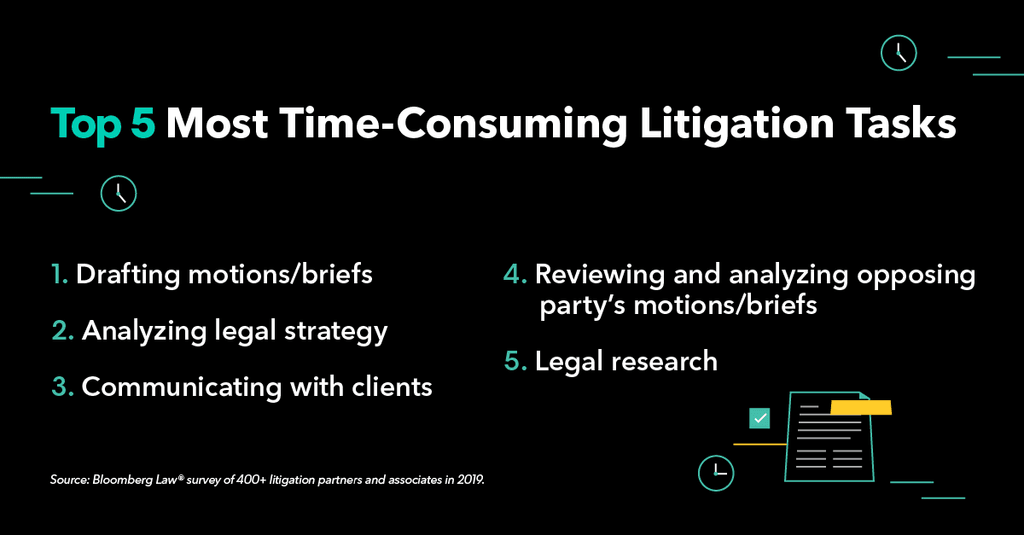ARTICLE
Litigators Sound Off on Their Most Time-Consuming Task
February 7, 2020

In today’s fiercely contested litigation environment, the smallest legal nuance can tip the scales from victory to defeat. These stakes, coupled with the dynamic nature of motions in which myriad standards must be applied, necessitate looking beyond traditional legal research methods.
From the outset, legal professionals face competing demands. “Lawyers are often balancing time and completeness, and brief writing is no different,” said Mindy Rattan, litigation team lead for analysis at Bloomberg Law®. “One point of tension is figuring out when research is complete.”
That determination has become harder to make, as online legal information grows in volume and complexity. The plethora of data privacy regulations alone is difficult to track and increases the risk of omitting an important case, statute, or agency ruling from brief citations.
These factors further strain an already challenging environment, in which material cited in opposing counsel briefs must be cross-referenced with original sources. However arduous, this exercise remains essential to pinpoint questionable authority citations and ellipses that may distort original legal argument intent.
[Maximize efficiency with the power of AI with Bloomberg Law’s Brief Analyzer. Request Demo.]
Among other time-intensive tasks, “Hyperlinking to precedents [made] brief preparation more cumbersome,” said Tim Berg, business litigation director at Fennemore Craig.
These challenges explain why brief writing – likened by many associates to a “pit in the stomach” – saps morale and budgets. Long-term consequences are increasingly hard to ignore, amid growing focus on lawyer well-being, as well as client resistance to the billable hour model for routine tasks.
“Law firms that continue to rely on traditional legal research methods in drafting and responding to motions will be at a significant disadvantage going forward,” said David Kleiman, product development manager at Bloomberg Law.
“Clients are no longer willing to pay for hours of legal research, when other firms are utilizing the latest cutting-edge technology to get work done more efficiently,” Kleiman said.

Even still, legal research continues to command significant firm time and resources, found a 2019 Bloomberg Law survey. A majority of litigators –84% – rank drafting motions as the most time-consuming task, requiring on average more than 20 hours of work in a month.
In the same survey, legal research rounds out the list of most time-consuming tasks. This sentiment cuts across all firm levels, from associate to partner ranks. However, only 76% of time spent by junior associates on legal research – and 74% of time spent on reviewing and analyzing opposing party motions – is recoverable.

By extension, roughly a quarter of legal research costs are absorbed, highlighting the perils of traditional legal research methods to briefs – and the bottom line.
Yet client expectations remain high. “Clients want their counsel to win and, more importantly, win efficiently,” Kleiman said. In this way, technology can ease brief writing challenges, and shatter a few preconceptions along the way.
While conventional wisdom holds that firms resist new technology, Bloomberg Law’s survey found a clear majority of legal professionals – roughly 85% – believe specific technology could reduce time researching a brief and responding to motions. Moreover, over three-quarters stated the technology could reduce brief analysis time by at least 25% – the same percentage of time that firms currently absorb in conducting legal research.
Taking the long view, technology may not represent a radical break but rather a natural next step in an ongoing evolution. “Over the last 40 years, technology has continually changed brief writing and reading in a number of ways,” Berg said.
In the meantime, the legal brief writing – a task that evokes reactions such as “nerve-wracking,” “nightmare,” and “cold sweat” from law associates – continues to lag new legal information and client expectations, while deepening associate anxiety and client cost concerns.
Law firms must evolve to remain competitive. Legal brief writing provides a good starting point in that effort. Where appropriately implemented, technology can maximize legal research and tilt the scales in ways that win – efficiently.